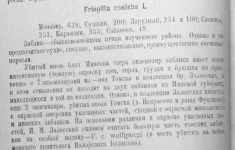Of the ones this far not dealt with in this thread (even if all´s not fully solved,) I can only add the following:
●Bulletin of the Biogeographical Society of Japan. Tokyo.
1944 Goura scheepmakeri wadai Yamashina, 14 (1), p. 1
Bulletin of the Biogeographical Society of Japan =日本生物地理学会会報
No digitized copy found, but available (in its original version) in several libraries (
here).
Also see
here:
No.1 山階 芳麿 Jan 1944
南ニューギニア産胸赤冠鳩の一新亜種に就て. 14: 1-2.
No.2 Marquis Yamashina, Yoshimaro Jan 1944
Two new subspecies of birds from Formosa and Yunnan. 14: 3-4
Maybe "No.2" is an English translation of No. 1, the one James is looking for?
●Japan Wildlife Bulletin. Tokyo.
1961 Parus montanus abei Mishima, 18 (1), p. 160 [in Japanese]
Japan Wildlife Bulletin = 農林省林野庁 [編]
No digitized version found, but available on, in CiNii (
here).
●Journal of the Chosen Natural History Society. Keijo [= Seoul].
1927 Garrulus brandtii okai Momiyama, 4, p. 5
Journal of Chosen Natural History Society =朝鮮博物學會雜誌 alt. Chōsen Hakubutsu Gakkai zasshi
No digitized version found, but available in several libraries (
here).
● Messager Ornithologique. Moscow.
1916 Coccothraustes coccothraustes tatjanae Kudashev, 7 (2), p. 96
"Messager ornithologique" = Ornitologicheskiĭ vi︠e︡stnik alt. Ornitologicheskii viestnik, with alternate title/s Messager ornithologique/Ornithologische Mitteilungen
No digitized version found, but available in several libraries (
here).
Vol. 1-6 is fairly easy to find, but "7" and "7 (2)" seems much harder to get a look at! However ("US access only");
here
].●Novedades Cientificas. Contribuciones Ocasionales del Museo de Historia Natural La Salle. Caracas.
1952 Formicarius rufipectus lasallei Aveledo & Gines, Zool., 6, pp. 1+
No digitized version found, but available in several libraries (
here).
●Transactions of the Natural History Society of Formosa. Taihoku [= Taipei].
1927 Zosterops palpebrosa kikutii Momiyama, 17, p. 304
Transactions of the Natural History Society of Formosa = Taiwan Hakubutsu Gakkai kaihō alt. Taiwan Hakubutsukan Gakkai kaiho
No digitized version found, but available in several libraries (
here).
---
That´s all I can manage in this thread.
But maybe someone is luckier (or better) searching the internet than I was on these titles?
If giving it a try; Good luck!
---





